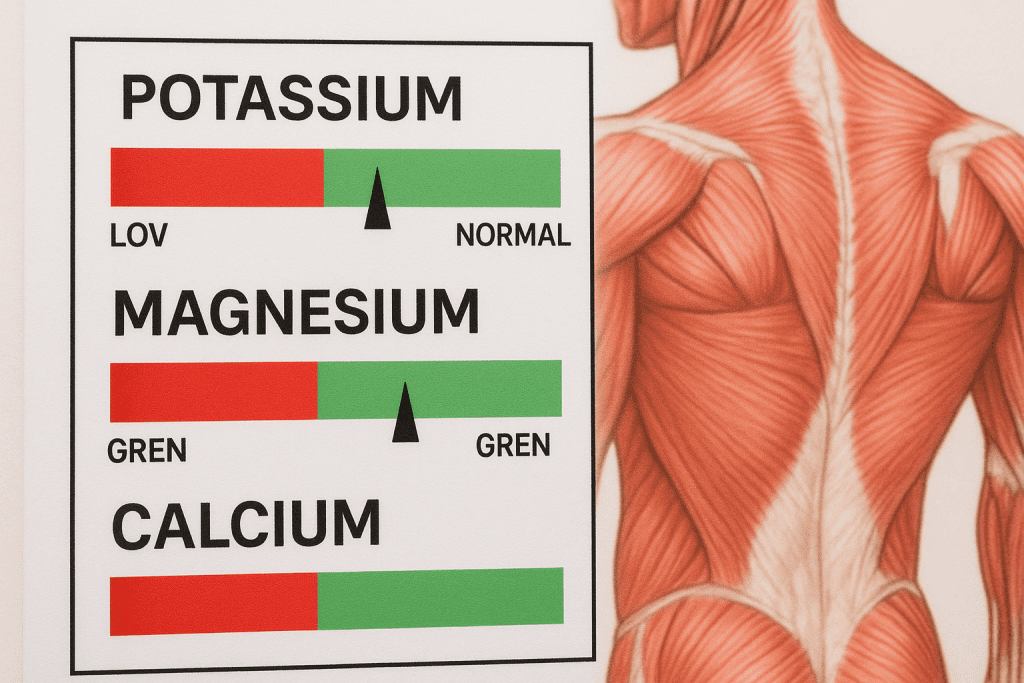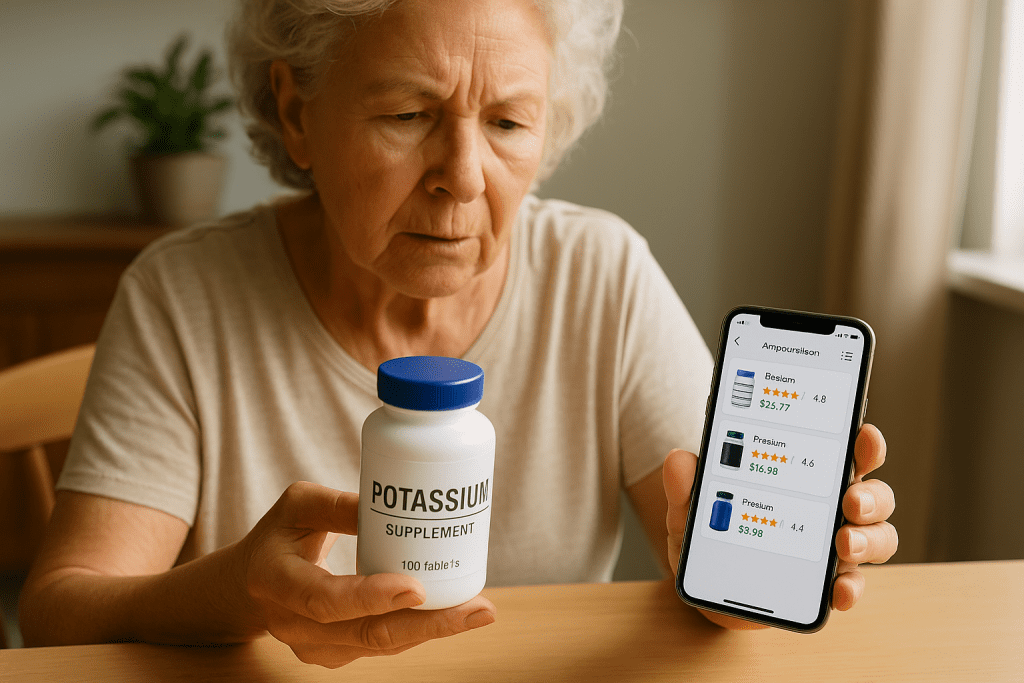Muscle cramps can be an uncomfortable side effect of diuretics, commonly known as water pills. While potassium supplements are often prescribed to fix the problem, they don’t always work – and in some cases, they may even make things worse.
This article breaks down the complex relationship between muscle cramps, diuretic potassium levels, and the broader picture of electrolyte imbalance cramps.
You’ll also learn when supplementation makes sense, what to avoid, and how to approach cramps with your healthcare provider’s guidance.
Quick Answer: How to Manage Muscle Cramps on Diuretics
| Concern | Best Practice |
|---|---|
| Cramps from diuretics | Can result from potassium, magnesium, or calcium loss |
| Potassium supplements | May help, but don’t always fix the problem |
| Electrolyte imbalance | Requires full panel monitoring, not just potassium |
| Hydration | Vital to prevent volume depletion-related cramping |
| Supplement safety | Risk of hyperkalemia with overuse or potassium-sparing diuretics |
| Action step | Regular lab tests and healthcare check-ins recommended |
How Diuretics Disrupt Electrolytes and Cause Cramps
Diuretics help lower blood pressure by pushing excess sodium and water out through the kidneys. But they often take vital electrolytes with them – especially potassium, magnesium, and calcium. That’s where trouble begins.

Potassium Loss Is Just One Piece
Loop and thiazide diuretics (like furosemide or hydrochlorothiazide) are especially known for depleting potassium. This can lead to hypokalemia, where nerve signals can’t travel properly to muscles. Result? Cramping, fatigue, even irregular heartbeats. According to Harvard Health, potassium loss is one of the most common causes of muscle cramps among people on water pills.
But here’s the twist: even potassium-sparing diuretics like spironolactone can cause cramping, not from loss – but from excess. If potassium builds up too high (a condition called hyperkalemia), it may trigger muscle spasms or twitching instead of preventing them.
Volume Depletion and Other Electrolytes Matter Too
Muscle cramps also stem from fluid imbalance – not just mineral shifts. All types of diuretics can cause volume contraction, which shrinks the fluid space between cells and stresses muscle fibers. This effect can persist even if potassium levels are corrected.
On top of that, magnesium and calcium losses can be just as important. Studies show that these two minerals play a central role in neuromuscular stability. So even with a potassium supplement, missing the broader water pills supplement synergy can leave cramps unresolved.
Potassium’s Role in Muscle Function and Cramp Prevention
Potassium helps muscles contract and relax by allowing electrical impulses to flow. When levels dip too low, those impulses get stuck, leading to tightness and spasms.

When Potassium Supplements Work
For people taking potassium-wasting diuretics, supplementing with potassium – either as pills or potassium-rich foods – can help restore balance. Guidelines published in JAMA Internal Medicine recommend supplements if dietary sources aren’t enough, especially in patients with confirmed hypokalemia.
Potassium is found in foods like bananas, sweet potatoes, spinach, and avocados. But dietary forms are usually coupled with phosphate, not chloride, which limits their usefulness in replacing the type of potassium lost during diuretic therapy.
Some doctors recommend extended-release potassium chloride tablets (like K-Dur or Klor-Con) to ensure a steady supply, especially if cramping is persistent.
When Potassium Alone Isn’t Enough
Despite its importance, potassium often isn’t the full solution. Electrolyte balance is a team effort. If magnesium or calcium is off, cramping can continue even with perfect potassium numbers.
The Risks of Supplementing Potassium Without Monitoring
Potassium supplements sound safe, but too much can be just as dangerous as too little – especially if you’re already on a potassium-sparing diuretic like spironolactone or amiloride.
Signs of Too Much vs. Too Little Potassium
| Condition | Symptoms |
|---|---|
| Hypokalemia (low) | Muscle cramps, weakness, fatigue, irregular heartbeat |
| Hyperkalemia (high) | Muscle twitching, nausea, chest tightness, numbness, slowed heartbeat |
According to Cleveland Clinic, high potassium can lead to cardiac arrest in extreme cases. That’s why supplements should always be guided by lab results, not symptoms alone.
Even combination water pills (like Dyazide, which mixes hydrochlorothiazide with triamterene) must be carefully managed. These aim to preserve potassium while still reducing fluid overload – but can still cause cramps or imbalances if not tailored to the patient.
If you’re on multiple medications, consider using a safe supplements checker for seniors on 5+ medications to avoid adverse interactions.
A Holistic Approach: Beyond Just Potassium
Relying on potassium alone to solve diuretic-related cramps is like fixing a car by only topping up one fluid. You need a complete checkup.

1. Test and Supplement All Key Electrolytes
Work with your doctor to test magnesium, calcium, and sodium in addition to potassium. Supplements like magnesium glycinate or calcium citrate may be recommended depending on the findings. In some cases, a multi-electrolyte blend may be helpful.
2. Stay Hydrated – Smartly
Proper hydration helps maintain fluid balance and supports electrolyte stability. However, for patients with conditions like heart failure, water intake must be carefully controlled. According to APEC Water and PubMed, both dehydration and overhydration can make cramps worse.
3. Adjust Diuretic Strategy
If cramps persist, your doctor may:
- Lower the diuretic dose
- Switch to a combination formula
- Rotate between diuretic classes
Patients with ongoing issues should also consider tools like our app comparing supplement brands for purity, which includes a symptom tracker for drug-nutrient side effects.
4. Explore Non-Supplement Therapies
Some doctors have used quinine sulfate, B vitamins, or even gabapentin for chronic cramping, though effectiveness varies and risks exist. Stretching exercises before bedtime can help reduce nocturnal leg cramps, a common problem among older adults on water pills.
Conclusion: Potassium Helps, But It’s Only Part of the Equation
Muscle cramps in people taking diuretics often stem from a mix of causes: potassium loss, magnesium or calcium depletion, fluid shifts, or even medication side effects. Potassium supplements may help if deficiency is confirmed – but they’re not a cure-all.
Managing electrolyte imbalance cramps requires a thoughtful, personalized approach. Start by working with your healthcare provider to monitor your full panel, explore balanced supplement options, and adjust your diuretic regimen as needed.
For more on supplement safety with medications, visit our guide on safe supplements for seniors on 5+ medications, or explore our brand purity comparison app.

